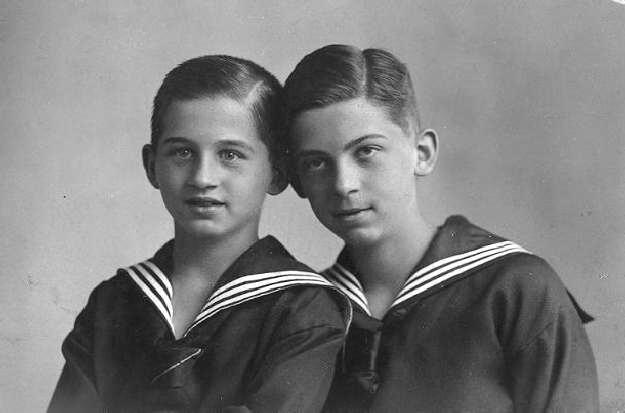
HBC Search Conventions

Figure 1.--This portrait was unidentified, but we think the boys are German. (In part because the way the sacarves are tied.) They look to be about 8 - 11 years old. The portrait was probably taken in the 1930s. We attempt to estimate ages and dates in tese impages to assist readers doing searches. Readers are invited to comment n our estimates to help refine the estimsates.
|
|
We have attempted to structure HBC to make in easy for readers to find the information needed. We almost always spell out countries and other words rather than use abreviatins that search engines will not pict up on. Often readers are interested in country informstion. And this need is primarily met by looking in the country section. But there are many HBC sections outside the country sectiions which have counry informsation or images. Thus we write out the countryy name, like Germany , and never use Ger. An exception here is the United States, we do often use America, but normally both terms will appear in the text on any given page. We normally use Soviet Union rather than USSR. We almost always use numbers when refrring to ages of children in the images and try to estimate ages when they are not available. This enables readers interested in the clothing worn by a crtain age groups to find the information. And we normally put the word "years" after the numeric age to differentiate age numbers from dates. We consistently use the American date conventions. This facilitates searches for readers interested in specific years or chronoloical periods. If readers have specific search requirements that are not being met, please inform HBC so we can adjust or adopt search conventions as appropriate.
Ages
Many readers are interested in the clothing worn by specific ages or age groups. And tere are often age oaragraphs on may of our style/garment pages. We almost always use numbers when refrring to ages of children in the images and try to estimate ages when they are not available. This enables readers interested in the clothing worn by a crtain age groups to find the information. And we normally put the word "years" after the numeric age to differentiate age numbers from dates.
Countries
Often readers are interested in country information. And this need is primarily met by looking in the country section. But there are many HBC sections outside the country sectiions which have counry informsation or images. Thus we write out the country name, like Germany , and never use Ger. An exception here is the United States, we do often use America, but normally both terms will appear in the text on any given page. We normally use Soviet Union rather than USSR.
Dates
HBC has an extensive chronological section. Many readers are interested in specific chronological periods. We consistently use the American date conventions. This facilitates searches for readers interested in specific years or chronoloical periods. An reader has pointed out, "I notice you put a date/time stamp at the bottom of most of your web pages. I also notice that the dates are in USA (mm/dd/yyyy) format, which is at odds with the normal European standard (dd-mm-yyyy). I just thought I would call your attention to the ISO (International
Standards Organization) standard 8601 (Google iso8601) which suggests that dates
should be in the format yyyy-mm-dd, which is unambiguous, since every standard which
puts year first also has the sequence year-month-day." Our reader makes a good suggestion. We are, however, reluctant to make any changes as this would mean because changing all of the existing dates is an impossible undertaking and we do not want a different date comnvention on some of the pages.
Garment Terms
HBC has an extensive garment/style section. Many garments were referred to by a range of terms. A good example of this is tunics and tunic suits. They were commonly referred to as Russian blouses, Bustern Brown suits, and a variety of other names. Manufacturers and retailers were not consistent. To facilitate searches, we have attempted to come with a stadard term that researchers can use to find informsation about these garments. There is often a "terminology" pararaph on garment pages to discuss this issue.
Others
If readers have specific search requirements that are not being met, please inform HBC so we can adjust or adopt search conventions as appropriate or possible.
HBC

Navigate the Historic Boys' Clothing Web Site:
[Return to the Main search topic page]
[Return to the Main HBC search engine page]
[Introduction]
[Activities]
[Bibliographies]
[Biographies]
[Chronologies]
[Clothing Style Index]
[Countries]
[Contributions]
[FAQs]
[Links]
[Glossaries]
[Images]
[Links]
[Registration]
[Boys' Clothing Home]
Created: 5:38 PM 8/9/2009
Last updated: 5:39 PM 8/9/2009



